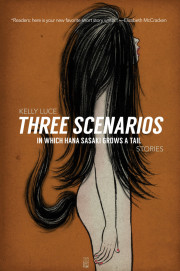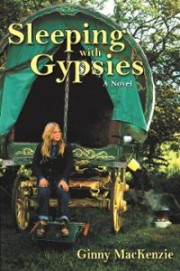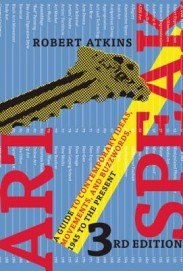 by Louis Bourgeois
by Louis Bourgeois
This interview came about by way of an error: I was in the throes of researching rants, poems, and manifestos for a show I was organizing, and I ordered Martin Puchner's Poetry of the Revolution: Marx, Manifestos, and the Avant-Gardes (Princeton University Press, 2005, $31.95) thinking it was an anthology of manifestos from the 19th and 20th centuries. It was not that, but rather an intensive analysis of the political and art manifestos from that era (The Communist Manifesto being the Mother of them all). The book entranced me, especially for its discussion of the sheer proliferation of manifesto writing from this time. There were so many manifestos being written, published, and distributed across Europe (and even America eventually), and the form was taken quite seriously by governments and individuals alike, that one gets the sense, at least briefly, that this indulgence of manifestos facilitated the wars and revolutions of the time. Perhaps more to the point, the manifesto proved to be the ideal conduit for projecting violent aphorisms for a culture that was headed down a linear path of destruction.
Martin Puchner is the Byron and Anita Wien Professor of Drama and of English and Comparative Literature at Harvard University. Besides Poetry of the Revolution, his other books include The Drama of Ideas: Platonic Provocations in Theater and Philosophy (Oxford, 2010) and Stage Fright: Modernism, Anti-Theatricality, and Drama (Johns Hopkins University Press, 2002). He is the general editor of the Norton Anthology of World Literature, third edition (2012) as well as of numerous scholarly volumes and sourcebooks. He also writes on literature, drama, and politics for the London Review of Books, Raritan, Bookforum, and other publications.
Louis Bourgeois is the Executive Director of VOX PRESS, a 501 (c)(3) arts organization based in Oxford, Mississippi. His memoir, The Gar Diaries, was recently re-published by the U.K. publisher, The Other Publishing Company. His Collected Works is due out by Xenos Press in 2016. Bourgeois is also the founder and director of the Prison Writes Initiative, a writing program set-up for Mississippi inmates.
Louis Bourgeois: I want to start with two blatant questions so the reader will know where we are from the very beginning. First, what exactly is meant by the term “avant-garde” and secondly, what compelled you to write a whole book on manifestoes?
Martin Puchner: Originally, “avant-garde” is a military term. It means the most advanced corps of an army, the part that is ahead of the main corps, the opposite of the rear guard, which guards the back. Over the course of the 19th century, this term wanders into the art world, where it acquires a second meaning: a group of artists that is ahead of everyone else. The military provenance lingers on in the often aggressive demeanor of these advanced artists. Like their military counterparts, they see themselves as the most daring members of their group, the ones who are paving the way for everyone else. This etymology raises an obvious question: why would the art world in the later 19th century think that way? To be sure, there had always been artists who violated accepted artistic conventions and who wanted to establish new ones. But to think of the entire art world this way, that there was a rear guard, a main corps, and an avant-garde, that was new.
I’ve always been both fascinated and bothered by manifestos. Fascinated, because there was this sudden explosion of manifestos in the early 20th century, and bothered (but also thrilled) by their aggressive demeanor, their often facile claims, and their shrill tone. I decided to write a book about them when I realized that this new genre was a perfect way of capturing the art world of the late-19th and 20th century, the art world of the avant-garde. That was the main reason. The second, related reason was that the great theme of 20th century art was its relation to politics. A lot of ink had been spilled on that topic. The manifesto seemed like a tangible way of addressing this question because manifestos bridged the divide between art and politics. It allowed me to observe how politics influenced art and vice versa without having to make very general claims about all art being either entirely political or not political at all.
LB: Modernist writers such as Wyndham Lewis and Ezra Pound seem to adopt the form of the manifesto quite reluctantly—they seem to approach it with disgust. What is it about the manifesto that revolted these angelic modernists?
MP: Ah, nicely put. Yes, Anglo-American artists were more reluctant with respect to manifestos for various reasons. First, they had always had a complicated relation to the Continent, and manifestos were very much a product of the Continent, especially France, Italy, and Germany. So there was always the question: to what extent do we want to adopt this Continental fashion? The second reason was the immense success of manifestos. Suddenly, they were everywhere and it became more difficult to compete in that environment—to have your manifesto stand out and be heard. One reaction was to reject manifestos entirely and try to do something new. The other reaction was to adapt manifestos, to come up with new ways of writing manifestos. Many Anglo-American writers opted for the former. Lewis and Pound opted for the latter, not exactly rejecting manifestos, but coming up with their own ways of writing them and incorporating them into their work.
LB: Yet in your book you refer to Pound and his cohort as the “rear guard,” rather than “the avant-garde.”
MP: The main reason I do so was Pound’s ambivalence with respect to Continental avant-gardes, which I think you hint at in your previous question. Pound was confronted with all these radical experiments on the Continent that were making their way across the channel, for example in the form of an attempt to create a London branch of Italian Futurism. Pound and his associates felt threatened by this invasion and found themselves fending off these attempts. The way they did this was by adopting some of the avant-garde strategies and techniques, including manifestos, but also by redirecting these radical energies back into more traditional, if experimental, art making. I should clarify that by rear-guard I do not mean they were artistically conservative or traditionalist; they were seen in England as quite radical in comparison with Edwardian art. But with respect to the Continent, they found themselves in a position of slowing things down and redirecting radical energies. Since the artistic “avant-garde,” in keeping with the military metaphor, thinks of itself as being ahead, the most radical, this term didn’t seem to fit. So I chose, by analogy, the term “rear-guard.”
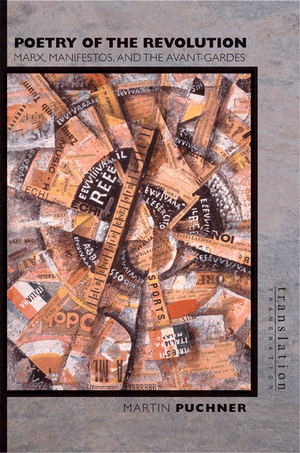 LB: In Poetry of the Revolution, you write at length about the dual history of the manifesto. I was intrigued by this brief passage: “It is, however, on this double history of the political manifesto and the art manifesto, on the assumption that the history of the art manifesto in the twentieth century must be written as part and parcel of a history of socialism, that my methodology is based.” How do these two histories play off of each other and how do they both tie into the greater abstraction of the word Socialism?
LB: In Poetry of the Revolution, you write at length about the dual history of the manifesto. I was intrigued by this brief passage: “It is, however, on this double history of the political manifesto and the art manifesto, on the assumption that the history of the art manifesto in the twentieth century must be written as part and parcel of a history of socialism, that my methodology is based.” How do these two histories play off of each other and how do they both tie into the greater abstraction of the word Socialism?
MP: I had identified this interesting object, the genre of the manifesto, with its political history and its sudden move into the art world. So I spent a lot of time thinking about the political orientation of the manifesto. Was it a politically neutral genre, equally used by the right and the left? At first blush this seemed to be the case, since there always existed right-wing manifestos, both in the political world and in the art world. But the more I thought about it, the more it became clear that the manifesto was not politically neutral. It was part of a history of leftist revolt, in part because of the overwhelming influence of The Communist Manifesto on the whole genre. There were manifestos before The Communist Manifesto, but The Communist Manifesto really changed everything. So I found that the history of leftist revolt was in a sense embedded in the genre of the manifesto. It would have been wrong to treat the manifesto as a neutral genre and to study it in a purely literary, formal fashion. What was interesting was precisely the way it was bound up with political, and especially the history of socialism. For socialism, The Communist Manifesto was a foundational text, but one that had to be carefully updated from time to time. So socialism in this sense means the different official socialist organizations, from the Second International to the Third International to the Fourth International. Official Socialism, so to speak. At the same time, the history of socialism is a history of splinter groups, all with their own manifestos, so a study of manifestos needed to be part of that history as well.
LB: In the chapter “Fascism and Revolution,” you write: “There existed a conduit for the manifesto to move from politics to art: the notion of the avant-garde.” But I wanted to know if you could talk about the opposite direction, art moving toward the political. After all, is that not the very transmogrification we see in the post-war works of Ezra Pound?
MP: Yes, good point. Since manifestos existed in both art and politics, they lend themselves to studying the move from the one to the other, and vice versa. In other words, if you want to observe how an artist seeks to break into politics, look at how he or she uses manifestos. Marinetti is a perfect example. First, he uses a political genre, the manifesto, and introduces it into art: Futurism is born. This is the move from politics to art. But you are absolutely right that there is a move in the opposite direction as well, and interestingly, Marinetti is a good example of that as well. So he has used the manifesto to politicize art. But in a second step, he wants to move this newly politicized art (Futurism) back into politics. How so? He starts to form a political wing of Futurism and does so by writing political manifestos. Now he aestheticizes politics. (Mussolini didn’t let him get away with it, however, and basically told him to stick to art and leave politics alone).
Marinetti is a more clear-cut case of both moves, but Pound can be seen from this perspective as well. In an often confusing way, his political opinions, including his strange theories of economics, debt, and usury, spill into his art, and vice versa.
LB: Did Marinetti's Futurist Manifesto give rise to Italian Fascism, or did it serve as a cultural mirror reflecting what was historically inevitable?
MP: No, Marinetti’s manifestos did not give rise to Italian Fascism. I would rather say that they accompany it. Most Italian Fascists emerged from a particular strand of socialism, from which they split at the outbreak of WWI, becoming hyper-nationalist, pro-war, etc. This is true of both Mussolini and Marinetti. So I would say the same conditions gave rise to Fascism and Futurism. Marinetti wanted to turn Futurism into the artistic wing of Fascism, but Mussolini kept him at arm’s length. In other words, both emerged from the same milieu, but moved in different directions, with some limited overlap.
LB: You write at length about the similar overlap of, and differences between, war and revolution. Can you summarize your notion here?
MP: Wow, a big topic to summarize, but I’ll try. The main distinction between war and revolution is that war is an event that takes place between nations or empires or other political units, while revolution is an event within a political unit. In this sense, revolution is more akin to a civil war, which also is a violent event within a political entity. This is why I said a revolution could be described as a particular kind of war. But not all civil wars are revolutions. The U.S. civil war, for example, was not. So a revolution is a civil war that aims at the violent overthrow of a ruling class, and not just a ruling class, but an entire political system. This, in any case, is our modern notion of revolution.
The term “revolution” has undergone a complete shift. It used to mean a continuous cyclical movement, for example the revolution of the stars around the sun. But in the 18th century, it acquired our current meaning, the sudden overthrow of an existing order. On the face of it, this is almost the opposite meaning, not a cyclical, continuous movement, but a sudden change. Why this shift in meaning? One reason was that the makers of the French Revolution, the most paradigmatic revolution, didn’t think they were introducing sudden change. Rather, they thought they were restoring an old order, that they were going back to a time when things had been better. Marx talks about this in his work The 18th Brumaire. They thought they were returning to the past, revolving back. But as we know, what they actually did was something completely new.
LB: What are some of the connections between Fascism and Socialism—I’m referring specifically to your section “ Revolution to War.” Perhaps quite a few readers do not realize that Mussolini started off as a “socialist.” What type of socialist was he? What did socialism mean in Italy at that time?
MP: Yes, most Italian Fascists were socialists, including Mussolini. The big turning point was World War I. The official party line of the Second International was an anti-war stance. Quite a number of Italian Socialists could not stomach this stance in the war-enthusiastic summer of 1914, and therefore broke with the Second International. This happened in many European countries, not just in Italy. But especially in Italy, Fascism has deep roots in Socialism. This also explains why Fascism to some extent continued to speak of itself as “revolutionary” even though it comes to oppose the left violently. Even the “socialism” in “German National Socialism” was not merely rhetoric at the beginning.
LB: What strikes me the most from reading Poetry of the Revolution is the sheer proliferation of the manifesto throughout Europe in the late 19th and early 20th centuries. I was of course aware of the manifesto as an important genre, but was not aware of its mass appeal. At times, you even seem to suggest the manifesto itself enacted the World Wars!
MP: Yes, this is what struck me, also: the proliferation of manifestos. I think it is rare that a new genre takes over so quickly. It’s important to remember, however, that many manifestos remained quite obscure. Even The Communist Manifesto didn’t develop mass appeal until the 1880s and ’90s, fifty years after it was written. This is the case even more so with most artistic manifestos. Some of these manifestos were widely known, especially the futurist ones since Marinetti was a great PR man. But many, many remained niche products. This posed an interesting challenge for me. Manifestos, their sheer proliferation, clearly captured something crucial about this time. At the same time, I needed to be careful not to fall for their own exalted rhetoric. Manifestos exaggerate above all their own influence and importance. In other words, many manifestos, perhaps all manifestos, failed—at least by their own extreme standards. After all, they all wanted to change the world, and it is difficult to change the world. Marx knew this better than anyone, when he wrote in the opening lines of The 18th Brumaire: “Men make their own history, but they do not make it as they please; they do not make it under self-selected circumstances.” Many manifestos ran up against this truth and wanted to make history as they pleased. So I needed to find a way of talking about the failure of individual manifestos. I did so by making a distinction between performative manifestos and theatrical ones. Many manifestos ended up being merely “theatrical,” without the force needed to actually change the world. At the same time, I found that while many—most—individual manifestos failed, as a genre they did change the world. Not by directly causing wars or revolutions, but by articulating ideas, capturing a mood, in a particular way. Having said this, The Communist Manifesto is certainly one of those texts that actually had an effect.
LB: What would you say is the “New Poetry of the Revolution,” as it attempts to hide itself in the 21st century? I’ve looked everywhere and don’t even see a glimpse of it, anywhere.
MP: The closer my history of manifestos came to the present, the fuzzier the picture became, unsurprisingly so, I suppose. The present is always confusing and we lack the historical distance to view it clearly. One thing seemed quite clear, however: our present moment is very different from the revolutionary frenzy of the first half of the 20th century. And this is mirrored in the decline of manifestos, as one would expect.
At the same time, I have been struck by the fact that manifestos continue to be written even today, albeit more hesitantly so. Especially in the art world. There is a yearning for manifestos, and different cultural institutions—galleries, journals—commission manifestos or encourage artists to write them. Something similar is happening in politics. There was a debate among the people involved in Occupy! whether to write a manifesto. No manifesto of this movement was written, but attempts were made in this direction, for example by N+1. So, again, a sense that manifestos can’t quite be written as they used to, that our time is different, but at the same time a grappling with this difference, and at times a yearning for manifestos, or something like manifestos. This defines the present moment from the point of view of manifestos for me.
LB: I was hoping you could clarify the positions of the later avant-garde groups, the Situationists, the Lettrists, and the Imagists Bauhaus. I once did a full-blown interview with a friend, in French, with die-in-the-wool Lettrist Roland Sabatier, and still have no idea what Lettrism was attempting to achieve.
MP: That must have been quite an experience. Today, Lettrism is mostly seen as a precursor to Situationism, although it was less explicitly political. One of the striking features of Situationism was the suspicion of art, and a critique of the avant-gardes of the early 20th century, including Surrealism, as somehow not radical enough. Lettrism is a link, I would say, between this earlier avant-garde and Situationism. I think you have no idea what Lettrism was attempting to achieve because they themselves had no idea what they were attempting to achieve. With a movement like this, it’s much less about a clear program or goals, than about a certain provocative attitude, a sensibility that tried to reconnect to the pre-World War II world of avant-garde art, the Dada-ist provocations of the Cabaret Voltaire, for example. The problem was that the world after World War II was a very different one, which is why Lettrism never really found a place for itself. It took another fifteen years until these wannabe avant-gardists found a way of articulating an avant-garde for post-war Europe.
LB: How does the notion of “counter cinema” play into your dissertation on the manifesto?
MP: The place where my project intersected with radical cinema was in the person of Guy Debord. I had known Debord for Society of the Spectacle, a critique of the image, an attempt to update a Marxist critique to the age of new media, especially advertisement, cinema, and television. But interestingly, Debord did not reject all image-making. Rather, he developed a way of using the image against the image, a kind of self-critical image. This led him actually to create a film version of Society of the Spectacle, a collage of media images overlaid with extracts from his manifesto. It is a kind of confrontation of manifesto and cinema. Of course, Debord was not the only one to create this kind of kind of counter cinema. The much better known figure was Godard, which is why Debord hated Godard. But the basic move, as I would describe it, is this: in a world saturated by images, what can a critical use of cinema be?
LB: And to come full circle: what is the avant-garde now in the 21st century?
MP: We are going through a media revolution even more extreme than that of the 20th century. I would say that an avant-garde for the 21st century would have to develop ways of using our own new media in critical, innovative, provocative ways. It would also have to be part of a political analysis of our moment, and translate that analysis into a new set of attitudes and ambitions. If that sounds vague, I suppose it has to be. Predicting the future is a fool’s errand. The history of manifestos is proof of that.
Click here to purchase this book at your local independent bookstore

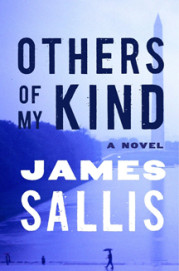 James Sallis
James Sallis


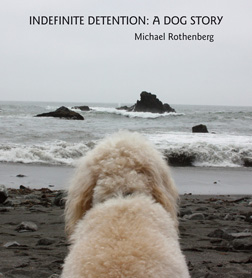 Michael Rothenberg
Michael Rothenberg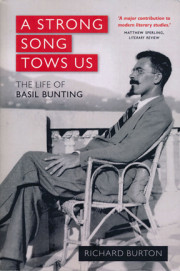
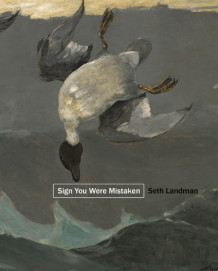
 by Louis Bourgeois
by Louis Bourgeois
